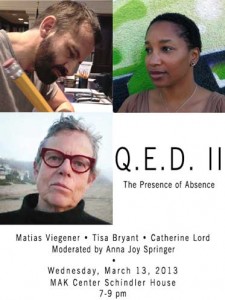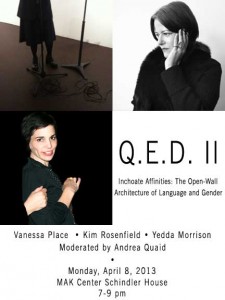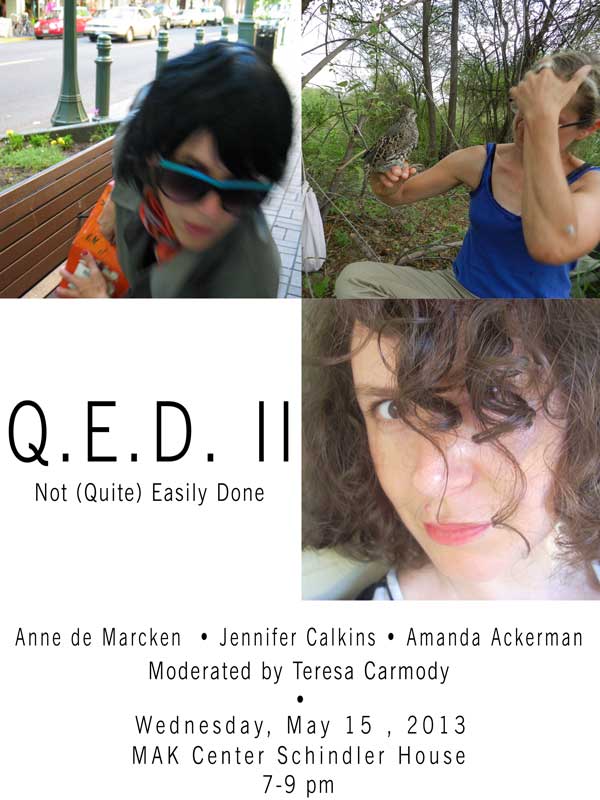Q.E.D. II is a series of performances curated around issues of affinity, influence, and provocation, hosted at the MAK Center for Art and Architecture, Schindler House, in West Hollywood. This program includes three events over the course of three months (March 13, April 8, and May 15); each evening features a Les Figues author alongside two additional writers and/or artists, whose work as impacted the author’s. Q.E.D. II builds on our 2012 Q.E.D. series on queer art and literature, including the questions Q.E.D. raised about bodies, sexuality, and identity. This year, Les Figues Press invites authors to act as both participant and curators—emphasizing communities of influence over issues of queerness—underscoring that both are bonds of affinity.
The program is curated by Les Figues Press and supported through a Cultural Resource Development Grant from the City of West Hollywood.
Q.E.D. references a novel by Gertrude Stein; Q.E.D. (Quod Erat Demonstrandum, or Things as They Are) was one of the earliest coming stories, written in 1903 though not published until 1950, after Stein’s death.
The Q.E.D. II series was reviewed at Jacket2 by Kim Calder. Read her coverage of each installment here:
- On QED II, part one: The presence of absence
- QED II, part two: Inchoate affinities
- QED II, part three: Not (quite) easily done
 Q.E.D. II: The Presence of Absence
Q.E.D. II: The Presence of Absence
Queer celebrates poverty of theory.
Make own stories out of gaps and silence.
Wednesday | March 13, 2013 | 7:00 p.m.
MAK Center for Art & Architecture at the Schindler House
835 N. Kings Road
West Hollywood, CA 90069
Featuring: Matias Viegener | Tisa Bryant | Catherine Lord
Moderated by Anna Joy Springer
In his curatorial statement, Matias Viegener writes:
“As I examine the community of artists and writers with whom I am in dialogue, many of them work in a discourse of perforation, annotation, lacunae, and the presence of absence. In a recent blog, Dodie Bellamy commented on the relation between queerness, theorization and fragments: ‘Queer celebrates poverty of theory. Make own stories out of gaps and silence.’ How indeed is the queer subject, the subject of the other, to be made present? What are the axiomatics of delivery? Are there other kinds of presence that are structured by forms of absence?”
 Q.E.D. II: Inchoate Affinities: The Open-Wall Architecture of Language and Gender
Q.E.D. II: Inchoate Affinities: The Open-Wall Architecture of Language and Gender
“Language is there to bewilder itself and others.” -Sabine Spielrein
Monday | April 8, 2013 | 7:00 p.m.
MAK Center for Art & Architecture at the Schindler House
835 N. Kings Road
West Hollywood, CA 90069
Featuring: Kim Rosenfield | Yedda Morrison | Vanessa Place
Moderated by Andrea Quaid
In her curatorial statement, Kim Rosenfield writes:
“In my writing, and in the artistic/intellectual communities I engage with, language can be moved, turned, buried, supported, doubled, transgenerationally transmitted, and softly assembled. Does gender, like language, like the radical design flow of this Schindler home, arrive from without to within and back out again? And if so, is the dividium the Self? In my work, and the work that I align with, texts are entirely appropriated, moving from strange attractor to strange attractor, able to bewilder and therefore expand or challenge capacities of ‘knowing.”
 QED II: Not (Quite) Easily Done
QED II: Not (Quite) Easily Done
“But life is not like that. There are no QEDs.” –Church Times, 2006 17 Nov. 19/1
Wednesday | May 15, 2013 | 7:00 p.m.
MAK Center for Art & Architecture at the Schindler House
835 N. Kings Road
West Hollywood, CA 90069
Featuring: Jennifer Calkins | Anne de Marcken | Amanda Ackerman
Moderated by Teresa Carmody
In her curatorial statement, Jennifer Calkins writes:
“Uncomfortable as it makes me, I have to agree with Church Times. I do not believe in Q.E.D. Nothing is demonstrated, nothing is quite easily done. The existence of two opposites at the same moment is just that. Or, it is only the mask of our perceptions, our cognition and our emotional reactivity, that hangs between us and the world like Los Angeles haze. I see in my work and the work of those I admire a constant return to the idea of that veil—glass darkly. Our intersections with the past, with the plants, with the nonhuman animals, are not about anything but our own speech. We are trying to reach outside of the echo chamber of our own minds towards something else, a sort of neat Q.E.D.—our own proof of the existence of ourselves and the other—that, even with the very tips of our fingers, the edge of our hair, we will never even brush.”
Comments are closed.